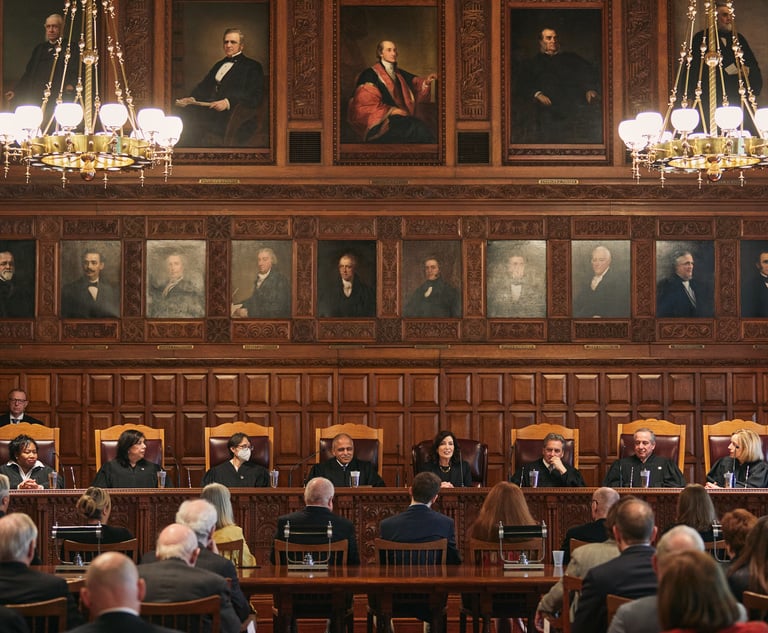It's the Alcohol, Not the Ice
There are other matters concerning guns and their use which should be considered, but none are as basic as the need to ban the sale of automatic weapons. Congress can pass those laws without doing damage to the Second Amendment and save thousands of innocent lives.
March 05, 2018 at 02:30 PM
5 minute read
 At last week's Conservative Action Political Conference, the President again committed himself to “defending 2nd Amendment rights.” The President, the NRA, and many members of Congress seem to believe that the Supreme Court is on their side when it comes to enacting gun laws, and the Second Amendment prohibits them from regulating the sale of guns. They are mistaken.
At last week's Conservative Action Political Conference, the President again committed himself to “defending 2nd Amendment rights.” The President, the NRA, and many members of Congress seem to believe that the Supreme Court is on their side when it comes to enacting gun laws, and the Second Amendment prohibits them from regulating the sale of guns. They are mistaken.
There are reasons to oppose the ban on assault weapons, but one of them should not be that such a ban would be prohibited by the Second Amendment.
After an assault weapon was used in the Sandy Hook school massacre, the state of Connecticut passed an Assault Weapon Ban Law outlawing the sale of over 100 named firearms including automatic weapons holding more than 10 rounds. The Connecticut law went further to define any part of a firearm designed or intended to convert a firearm into an “assault weapon” as an “assault weapon.” Several states, including New York, followed Connecticut's lead. The fight to declare these laws unconstitutional and violative of the Second Amendment failed and in June 2016, the U.S. Supreme Court let those gun laws stand. Other challenges to state laws banning the sale of automatic weapons also failed.
The Supreme Court took note of these laws. When a similar law in Illinois was rejected by the Supreme Court, Justice Clarence Thomas wrote in dissent “that such weapons are legally owned and used by millions of Americans and should not be banned for the purpose of creating a sense of security.” Justice Antonin Scalia agreed with him, but the other justices did not.
In 2016, the San Francisco-based U.S. Circuit Court of Appeals for the Ninth Circuit upheld California's law, which imposed a 10-day waiting period before a licensed weapon of any sort could be sold. The waiting period would allow officials time to run background checks to be certain that weapons would not be sold to someone prohibited from gun ownership. Again, the NRA joined in a lawsuit declaring the California law as violating the Second Amendment. Within a week after the Parkland shooting, on February 20th, the Supreme Court declined to take up the California waiting period law. Justice Thomas again dissented, bemoaning the “general failure to afford the 2nd Amendment the respect due an enumerated constitutional right.”
These recent decisions confirm the recognition that gun laws, designed to protect us, are fully compatible with the Second Amendment. It also confirms the Supreme Court's original holding in the Heller case that “the right secured by the Second Amendment is not unlimited *** we think that limitation is fairly supported by the historical tradition of prohibiting the carrying of 'dangerous and unusual weapons.'”
When I trained in the military, the combat weapon of choice was the Garand M1. It was an automatic rifle that was capable of carrying an 8-10 round magazine. The M1 had to be aimed from the shoulder, and fired one round at a time. Too slow, too heavy, not tactically suited to modern warfare and unable to kill the enemy in large numbers. Ultimately, the military weapons of choice were derived from prototypes of the Armalite rifle (that's what the AR in AR-15 comes from). It is an excellent weapon which should be used in combat, but it should not be in the hands of civilians.
AR-15s and variants are the automatic weapons which were used in the 2012 Sandy Hook Elementary School shooting, the 2012 Aurora shooting, the 2015 San Bernardino attack, the 2016 Orlando night club attack, the 2017 Las Vegas shooting, and the 2018 Stoneman Douglas High School shooting. It is a weapon which has proven itself as an effective killing machine and, with adaptation as in the Las Vegas shooting, can be capable of firing more than 1,100 rounds in six minutes.
There is a story told of an experiment conducted for the purpose of determining the cause of drunkenness. Three drinks were prepared: one was vodka over ice, one was scotch over ice, and the third was bourbon over ice. All three of the drinks led to inebriation. The fact that ice was the common denominator of all three drinks led the experimenter to conclude that ice was the cause of the intoxication.
I was reminded of this apocryphal story when listening to Wayne LaPierre this week repeating the same line he uttered after the mass shooting at Sandy Hook: “Guns don't kill people, people kill people.” Following the analogy: It is true that mass murder is caused by people—but those people have easy access to automatic weapons which were built, sold, and used to kill people in great number. The fact is that drunkenness is caused by alcohol not ice. And the mass murder of innocent civilians and school children have been caused by automatic weapons.
Sen. Marco Rubio said that if someone wants to commit mass murder, he can always find a way to get an automatic weapon. I suppose the same thing can be said of opioids, but I don't think anyone would suggest that we should not attempt to stop the proliferation of those drugs simply because and addict “can always find a way” to get them. Of course there are other matters concerning guns and their use which should be considered, but none are as basic as the need to ban the sale of automatic weapons. Congress can pass those laws without doing damage to the Second Amendment and save thousands of innocent lives.
Sol Wachtler, a former chief judge of the New York State Court of Appeals, is a distinguished adjunct professor at Touro College Jacob D. Fuchsberg Law Center.
This content has been archived. It is available through our partners, LexisNexis® and Bloomberg Law.
To view this content, please continue to their sites.
Not a Lexis Subscriber?
Subscribe Now
Not a Bloomberg Law Subscriber?
Subscribe Now
NOT FOR REPRINT
© 2025 ALM Global, LLC, All Rights Reserved. Request academic re-use from www.copyright.com. All other uses, submit a request to [email protected]. For more information visit Asset & Logo Licensing.
You Might Like
View All
Jimmy Carter’s 1974 Law Day Speech: A Call for Lawyers to Do the Public Good
14 minute readTrending Stories
Who Got The Work
Michael G. Bongiorno, Andrew Scott Dulberg and Elizabeth E. Driscoll from Wilmer Cutler Pickering Hale and Dorr have stepped in to represent Symbotic Inc., an A.I.-enabled technology platform that focuses on increasing supply chain efficiency, and other defendants in a pending shareholder derivative lawsuit. The case, filed Oct. 2 in Massachusetts District Court by the Brown Law Firm on behalf of Stephen Austen, accuses certain officers and directors of misleading investors in regard to Symbotic's potential for margin growth by failing to disclose that the company was not equipped to timely deploy its systems or manage expenses through project delays. The case, assigned to U.S. District Judge Nathaniel M. Gorton, is 1:24-cv-12522, Austen v. Cohen et al.
Who Got The Work
Edmund Polubinski and Marie Killmond of Davis Polk & Wardwell have entered appearances for data platform software development company MongoDB and other defendants in a pending shareholder derivative lawsuit. The action, filed Oct. 7 in New York Southern District Court by the Brown Law Firm, accuses the company's directors and/or officers of falsely expressing confidence in the company’s restructuring of its sales incentive plan and downplaying the severity of decreases in its upfront commitments. The case is 1:24-cv-07594, Roy v. Ittycheria et al.
Who Got The Work
Amy O. Bruchs and Kurt F. Ellison of Michael Best & Friedrich have entered appearances for Epic Systems Corp. in a pending employment discrimination lawsuit. The suit was filed Sept. 7 in Wisconsin Western District Court by Levine Eisberner LLC and Siri & Glimstad on behalf of a project manager who claims that he was wrongfully terminated after applying for a religious exemption to the defendant's COVID-19 vaccine mandate. The case, assigned to U.S. Magistrate Judge Anita Marie Boor, is 3:24-cv-00630, Secker, Nathan v. Epic Systems Corporation.
Who Got The Work
David X. Sullivan, Thomas J. Finn and Gregory A. Hall from McCarter & English have entered appearances for Sunrun Installation Services in a pending civil rights lawsuit. The complaint was filed Sept. 4 in Connecticut District Court by attorney Robert M. Berke on behalf of former employee George Edward Steins, who was arrested and charged with employing an unregistered home improvement salesperson. The complaint alleges that had Sunrun informed the Connecticut Department of Consumer Protection that the plaintiff's employment had ended in 2017 and that he no longer held Sunrun's home improvement contractor license, he would not have been hit with charges, which were dismissed in May 2024. The case, assigned to U.S. District Judge Jeffrey A. Meyer, is 3:24-cv-01423, Steins v. Sunrun, Inc. et al.
Who Got The Work
Greenberg Traurig shareholder Joshua L. Raskin has entered an appearance for boohoo.com UK Ltd. in a pending patent infringement lawsuit. The suit, filed Sept. 3 in Texas Eastern District Court by Rozier Hardt McDonough on behalf of Alto Dynamics, asserts five patents related to an online shopping platform. The case, assigned to U.S. District Judge Rodney Gilstrap, is 2:24-cv-00719, Alto Dynamics, LLC v. boohoo.com UK Limited.
Featured Firms
Law Offices of Gary Martin Hays & Associates, P.C.
(470) 294-1674
Law Offices of Mark E. Salomone
(857) 444-6468
Smith & Hassler
(713) 739-1250









